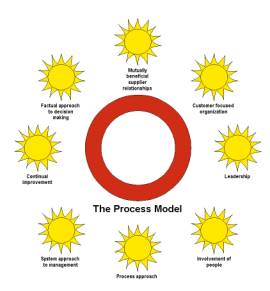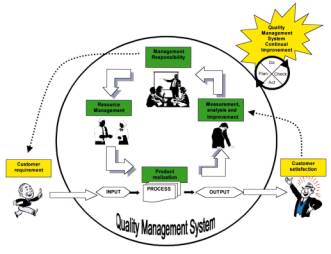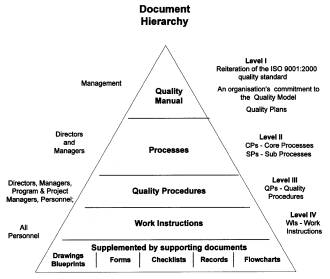“Where do we go now?!”
The History of Quality Standards
By Ray Tricker MSc IEng, FinstM, FIIE(elec), FIQA, MIRSE
Quite a lot of people have said that today’s ISO 9000 originated from the UK’s Munitions Standard which was developed in the early 1900’s to guarantee that bullets used during the 1st World War were good (and safe!) enough to be fired.
I tend to believe, however, that the actual ‘start’ of ISO 9000 was probably during the 1950 US Polaris programme when Admiral Rickover became frustrated at the delays caused by quality breakdowns, defects and errors. He took thirty fresh graduates from Harvard and sent them out into the industrial jungle to investigate.
When they returned, Rickover discovered that there were eighteen major items, which were the most common, or root cause of all the problems experienced. These eighteen points were then used as the cornerstone for quality in the American Space Research Programme and eventually became the basis of the first AQAP specifications defining the Quality Management System (QMS) requirements to be adopted by all NATO military subcontractors.
![]()
1979
BSI had already published a number of guides on quality assurance and, with the increased requirements for some sort of auditable quality assurance, they set up a study group to produce a document that would cover all requirements for a two party manufacturing or supply contract. This became the BS 5750:1979 series of standards. In the meantime, America had been working on their ANSI 90 series and other European countries were also busily developing their own standards. Quite naturally, as BSI had already produced and published an acceptable standard, most of these national standards were broadly based on BS 5750:1979.
|
|
|
|
|
|
1981
In 1981, the Department of Trade and Industry (DTI) formed a committee called ‘FOCUS’ to examine areas where standardisation could benefit the competitiveness of British manufacturers and users of high technology. In the United States, the Corporation of Open Systems (COS) was formed to pursue similar objectives and in 1983 ISO set up a study group to produce an international set of standards that all countries could use.
|
|
|
|
|
|
1987
Similar to quality standards from other countries, ISO’s standard was based on BS 5750:1979 and so when ISO 9000 was first published in 1987, it was immediately ratified by the UK and republished by BSI (without deviation), as the new BS 5750:1987 standard for QMSs.
Likewise, on 10 December the European Committee for Standardisation (CEN) approved and accepted the text of ISO 9000:1987 as the European Standard - without modification - and republished it as EN 29000:1987.
BS 5750:1987 was, therefore, identical to ISO 9000:1987 and EN 29000:1987 and was not just the British Standard for ‘Quality Management Systems’, it was also the European and the international standard
BS EN ISO 9001:2000
1994
ISO, realising that the problems of calling the same document by a variety of different names was confusing (some might say even a bit ridiculous!), published the ISO 9000:1994 series of documents and, by the end of the decade, more than 150 countries had ratified ISO 9000 as their accepted quality standard. Indeed, such is the interest that during 1999 over 350,000 certificates had been awarded worldwide. Europe with 190,000 certificates awarded is still a rapidly growing market closely followed by the Far East with 56,000 and North America (with 12,000 certificates awarded in 1999) showing an annual growth of 34.6%
|
|
|
|
|
|
2000
With the end of the millennium there was no slowing down in the development of quality standards, but as more and more organisations were expected to have ISO 9000 certification, it became apparent that the existing structure of the standard would not suit all eventualities. This was especially relevant to the smaller organisations that did not necessarily have the resources to implement all the requirements.
With this in mind, the members of ISO set about seeking the views of their members to see how the current standard could be improved. The result is the development of ISO 9001:2000.
The three main standards
The new ISO 9000:2000 family is an all-encompassing series of standards that lay down requirements for incorporating the management of quality into the design, manufacture and delivery of products, services and software. The family consists of three primary standards supported by a number of technical reports. The three standards are:
ISO 9000:2000 Quality Management Systems - Fundamentals and vocabulary (superseding ISO 8402:1995). Describes the fundamentals of Quality Management Systems and specifies their terminology.
ISO 9001:2000 Quality Management Systems - Requirements (superseding ISO 9001:1994, ISO 9002:1994 and ISO 9003:1994). Specifies the requirements for Quality Management Systems for use where an organisation’s capability to provide a ‘product’ that meet customer and applicable regulatory requirements needs to be demonstrated. (‘Product’ has been defined (in ISO 9000:2000) as ‘a system of activities, which uses resources to transform inputs into outputs’. There are four agreed generic product categories; namely hardware, software, services and processed materials.)
ISO 9004:2000 Quality Management Systems - Guidelines for performance improvement (superseding ISO 9004-1:1994). Provides guidance on Quality Management Systems, including the processes for continual improvement that will contribute to the satisfaction of an organisation’s customers and other interested parties.
ISO 9004:2000 also includes the requirements of ISO 9001:2000 in text boxes inserted in appropriate places (which means, I suppose that organisations only need to purchase 9004 and not both of the standards - funny old world!). In addition, ISO 9004:2000 includes an annex giving guidance on ‘self-assessment’ to enable an organisation to check the status of their own QMS. This will probably be very useful for organisations that are considering applying for ISO 9001:2000 certification, but are unsure precisely what additional quality documentation will be required
The ‘consistent pair’
Although ISO 9001:2000 and ISO 9004:2000 have been developed together (with the same sequence, structure and intention to be used together) they may also be used as stand-alone documents. Thus, ISO 9001:2000specifies the requirements for a QMS (that can be used for internal application by organisations, certification, or contractual purposes) whilst ISO 9004:2000 gives guidance on a wider range of objectives aimed at improving an organisation’s overall performance. ISO 9004:2000 is not, however, meant as a guideline for implementing ISO 9001:2000 neither is it intended for certification or contractual use.
Correlation between ISO 9001:1994 and ISO 9001:2000

In ISO 9001:2000 , the 20 elements contained in the previous 1994 standard have been replaced by four major sections covering the management of resources, the quality of the product, the maintenance of quality records and the requirements for continual improvement. Their interrelationship with the 1994 standards is shown in the following table:
Comparison between ISO 9001:2000 and ISO 9001:1994
|
Clause No. |
ISO 9001:2000 Title |
ISO 9001:1994 correspondence |
|
|
|
|||
|
1 |
Scope |
1 |
|
|
2 |
Normative reference |
2 |
|
|
3 |
Terms and definitions |
3 |
|
|
4 |
Quality Management System |
|
|
|
4.1 |
General requirements |
4.2.1 |
|
|
4.2 |
Quality Manual. Control of documents. Control of records |
4.2.1, 4.2.2, 4.5.1, 4.5.2, 4.5.3, 4.16 |
|
|
5 |
Management Responsibility |
|
|
|
5.1 |
Management commitment |
4.1.1 |
|
|
5.2 |
Customer focus |
4.3.2 |
|
|
5.3 |
Quality policy |
4.1.1 |
|
|
5.4 |
Planning. Quality objectives. Quality management system planning |
4.1.1, 4.2.3 |
|
|
5.5 |
Management representative. Responsibility and authority. Internal communication |
4.1.2.1, 4.1.2.3 |
|
|
5.6 |
Management review |
4.1.3 |
|
|
6 |
Resource management |
|
|
|
6.1 |
Provision of resources |
4.1.2.2 |
|
|
6.2 |
Human resources (competence, awareness and training) |
4.1.2.2, 4.18 |
|
|
6.3 |
Infrastructure |
4.9 |
|
|
6.4 |
Work environment |
4.9 |
|
|
7 |
Product realisation |
|
|
|
7.1 |
Planning of product realisation |
4.2.3, 4.10.1 |
|
|
7.2 |
Customer-related processes |
4.3.2, 4.3.3, 4.3.4, 4.4.4 |
|
|
7.3 |
Design and development |
4.4.2, 4.4.3, 4.4.4, 4.4.5, 4.4.6, 4.4.7, 4.4.8, 4.4.9 |
|
|
7.4 |
Purchasing |
4.6.2, 4.6.3, 4.6.4, 4.10.2 |
|
|
7.5 |
Control of production and service provision. Identification and traceability. Customer property. Preservation of product |
4.7, 4.8, 4.9,4.10, 4.12, 4.15.2, 4.15.3, 4.15.4, 4.15.5, 4.15.6. 4.19 |
|
|
7.6 |
Control of monitoring and measuring devices |
4.11.1, 4.11.2 |
|
|
8 |
Measurement, analysis and improvement |
|
|
|
8.1 |
General |
4.10.1, 4.20.1, 4.20.2 |
|
|
8.2 |
Monitoring and measurement. Customer satisfaction. Internal audit. Monitoring and measurement of processes and products |
4.10.2, 4.10.3, 4.10.4, 4.10.5, 4.17, 4.20.1, 4.20.2 |
|
|
8.3 |
Control of nonconforming product |
4.13.1, 4.13.2 |
|
|
8.4 |
Analysis of data |
4.20.1, 4.20.2 |
|
|
8.5 |
Continual improvement. Corrective action. Preventive action |
4.1.3, 4.14.1, 4.14.2, 4.14.3 |
|
Key changes in the standards
The most important change to be found in ISO 9001:2000 is the emphasis on “process control”, “continual improvement” and “customer satisfaction”.
To achieve this, ISO 9001:2000 (and ISO 9004:2000) have been based on 8 quality management principles with a common process-oriented structure and harmonised terminology. These eight principles are:
· Customer focused organisation;
· Leadership;
· Involvement of people;
· Process approach;
· System approach to management;
· Continual improvement;
· Factual approach to decision making;
· Mutually beneficial supplier relationship.

Continual Improvement
Throughout ISO 9001:2000, the requirement for continual improvement is frequently (and heavily) emphasised. The following process model clearly shows how the four major sections of ISO 9001:2000 inter-relate (i.e. management responsibility, resource management, product realisation, measurement, analysis and improvement) and how the improvement processes continuously revolve around all other aspects of quality management.
Each of these four sections is then sub-divided into a series of elements or sub-sections but the most important element is Section 5.1 (Management commitment) which states that ‘top management shall provide evidence of its commitment to the development and improvement of the Quality Management System’.

The ISO 9001:2000 Process Model
Proof of conformity
The proof of conformity lies in an organisation being able to prove that their Quality Management System meets the requirements of ISO 9001:2000. Which means that the manufacturer, or supplier, must possess a fully auditable Quality Management System.
What is a Quality Management System?
A QMS is the organised structure of responsibilities, activities, resources and events that together provide procedures and methods of implementation to ensure the capability of an organisation to meet and exceed the quality requirements of the customer. To achieve this a QMS needs to be capable of demonstrating continuous improvement and prevention of non-conformity and to assist self-evaluation. It is the organisational structure of responsibilities, activities, resources and events that together provide procedures and methods of implementation to ensure the capability of an organisation to meet quality requirements.
This QMS will consist of the documented rules, procedures and instructions prepared in accordance with ISO 9001:2000. These are stated in the Quality Manual as well as the associated Core Processes, Procedures and Work Instructions.

|
Level 1 |
Quality Manual |
The main policy document that establishes the Organisation’s QMS and how it meets the requirements of ISO 9001:2000. |
|
Level 2 |
Processes |
Core and Sub Processes that describe the activities required to implement the QMS and to meet the policy requirements made in the Quality Manual. |
|
Level 3 |
Quality Procedures |
A description of the method by which quality system activities are managed. |
|
Level 4 |
Work Instructions |
A description of how a specific task is carried out. |
Permissible Exclusions
ISO 9001:2000 is focused towards ‘providing confidence, as a result of demonstration, in product conformance to established requirements’ and includes a clause entitled ‘permissible exclusions’. This clause allows organisations to formally ‘exclude’ certain non-applicable requirements of the standard, yet still claim conformance to it. However, only those organisations that can prove that the nature of their products, customers and/or the applicable regulatory requirements do not need to meet the full requirements of ISO 9001:2000 are allowed these exclusions. For example, organisations whose products require no design activities (and who would have previously sought ISO 9002:1994 certification) can claim to be in compliance with ISO 9001:2000 by excluding the requirements for design and/or development.
Integration of management systems
ISO 9001:2000 is intended to be compatible with other management system standards, in particular, those relating to the ISO 14001 environmental management system standard and, to some degree, the health and safety requirements of standards such as BS 8800. The overall intention is to enable an organisation to run one management system that addresses quality, the environment and health and safety.
Upgrading an exisiting ISO 9000:1994 certification
Although upgrading a organisation’s Quality Management System to ISO 9001:2000 will be fairly simple if that organisation is already certified to ISO 9001:1994, the impact on organisations who are currently only registered to ISO 9002:1994 and 9003:1994 (i.e. organisations not involved in the design and manufacture of a product) will probably be more difficult. Greater documentation will now be required by these organisations in order to demonstrate why service and design functions do not apply to their organisations and more detailed records will be needed.
However, although organisations already registered to the 1994 standard will have up to the end of 2003 in which to re-certify, it is strongly recommended that these organisations make a start on the transition to the new standard as soon as possible.
Footnote
It has to be said that much of the old standard has been preserved and the revisions that have been made have been aimed mainly at closing the gap between ISO 9000, QS 9000 for the automotive industry and TR 9000 for the telecommunications industry etc.
Ray Tricker is a well-known author, titles include ISO 9001:2000 for Small Businesses, CE Conformity Marking and New Approach Directives, and many others.
Ray can be contacted on: tel: +44 (0)1837 83111, fax: +44 (0)1837 83011,
email: enquiries@herne.demon.co.uk web: www.herne.org.uk